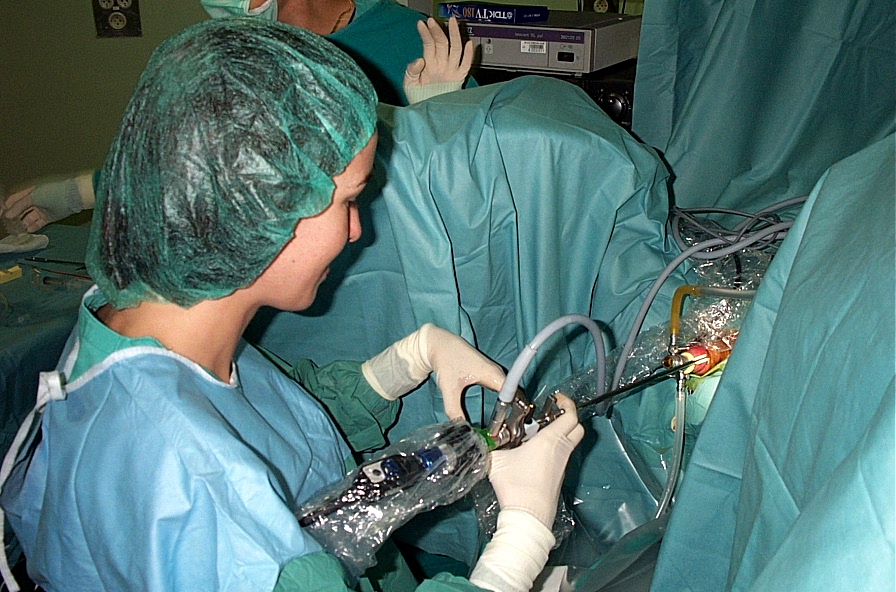|
GreenLight Laser Therapy
GreenLight Laser Therapy is a medical procedure for treating benign prostatic hyperplasia. It uses a laser beam to remove prostate tissue. The laser treatment is delivered through a thin and flexible fiber, which is inserted into the urethra through a cystoscope. GreenLight Laser Therapy has been increasingly performed as an alternative to transurethral resection of the prostate Transurethral resection of the prostate (commonly known as a TURP, plural TURPs, and rarely as a transurethral prostatic resection, TUPR) is a urological operation. It is used to treat benign prostatic hyperplasia (BPH). As the name indicates, ... in order to treat benign prostatic hyperplasia, with several studies demonstrating comparable results with fewer side effects and complications. Typically, it is an outpatient procedure which provides immediate relief of lower urinary tract symptoms. It is a virtually bloodless procedure and may be suitable for patients who cannot undergo traditional surg ... [...More Info...] [...Related Items...] OR: [Wikipedia] [Google] [Baidu] |
Benign Prostatic Hyperplasia
Benign prostatic hyperplasia (BPH), also called prostate enlargement, is a noncancerous increase in size of the prostate gland. Symptoms may include frequent urination, trouble starting to urinate, weak stream, inability to urinate, or loss of bladder control. Complications can include urinary tract infections, bladder stones, and chronic kidney problems. The cause is unclear. Risk factors include a family history, obesity, type 2 diabetes, not enough exercise, and erectile dysfunction. Medications like pseudoephedrine, anticholinergics, and calcium channel blockers may worsen symptoms. The underlying mechanism involves the prostate pressing on the urethra and thereby making it difficult to pass urine out of the bladder. Diagnosis is typically based on symptoms and examination after ruling out other possible causes. Treatment options include lifestyle changes, medications, a number of procedures, and surgery. In those with mild symptoms, weight loss, exercise, an ... [...More Info...] [...Related Items...] OR: [Wikipedia] [Google] [Baidu] |
Laser
A laser is a device that emits light through a process of optical amplification based on the stimulated emission of electromagnetic radiation. The word "laser" is an acronym for "light amplification by stimulated emission of radiation". The first laser was built in 1960 by Theodore H. Maiman at Hughes Research Laboratories, based on theoretical work by Charles Hard Townes and Arthur Leonard Schawlow. A laser differs from other sources of light in that it emits light which is coherence (physics), ''coherent''. Spatial coherence allows a laser to be focused to a tight spot, enabling applications such as laser cutting and Photolithography#Light sources, lithography. Spatial coherence also allows a laser beam to stay narrow over great distances (collimated light, collimation), enabling applications such as laser pointers and lidar (light detection and ranging). Lasers can also have high temporal coherence, which allows them to emit light with a very narrow frequency spectrum, spectru ... [...More Info...] [...Related Items...] OR: [Wikipedia] [Google] [Baidu] |
Cystoscope
Cystoscopy is endoscopy of the urinary bladder via the urethra. It is carried out with a cystoscope. The urethra is the tube that carries urine from the bladder to the outside of the body. The cystoscope has lenses like a telescope or microscope. These lenses let the physician focus on the inner surfaces of the urinary tract. Some cystoscopes use optical fibres (flexible glass fibres) that carry an image from the tip of the instrument to a viewing piece at the other end. Cystoscopes range from pediatric to adult and from the thickness of a pencil up to approximately 9 mm and have a light at the tip. Many cystoscopes have extra tubes to guide other instruments for surgical procedures to treat urinary problems. There are two main types of cystoscopy—flexible and rigid—differing in the flexibility of the cystoscope. Flexible cystoscopy is carried out with local anaesthesia on both sexes. Typically, a topical anesthetic, most often xylocaine gel (common brand names are A ... [...More Info...] [...Related Items...] OR: [Wikipedia] [Google] [Baidu] |
Transurethral Resection Of The Prostate
Transurethral resection of the prostate (commonly known as a TURP, plural TURPs, and rarely as a transurethral prostatic resection, TUPR) is a urological operation. It is used to treat benign prostatic hyperplasia (BPH). As the name indicates, it is performed by visualising the prostate through the urethra and removing tissue by electrocautery or sharp dissection. It has been the standard treatment for BPH for many years, but recently alternative, minimally invasive techniques have become available. This procedure is done with spinal or general anaesthetic. A triple lumen catheter is inserted through the urethra to irrigate and drain the bladder after the surgical procedure is complete. Outcome is considered excellent for 80–90% of BPH patients. The procedure carries minimal risk for erectile dysfunction, moderate risk for bleeding, and a large risk for retrograde ejaculation. Indications BPH is normally initially treated medically. This is done through alpha antagonist ... [...More Info...] [...Related Items...] OR: [Wikipedia] [Google] [Baidu] |
.png)

